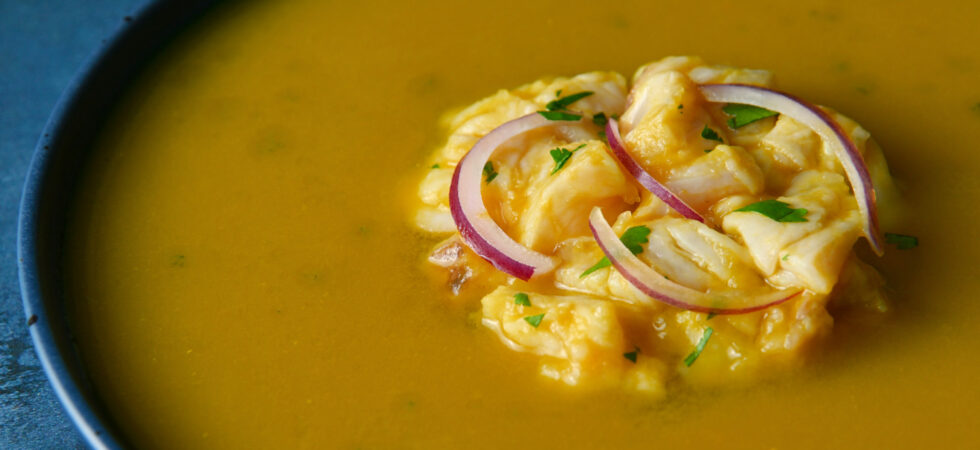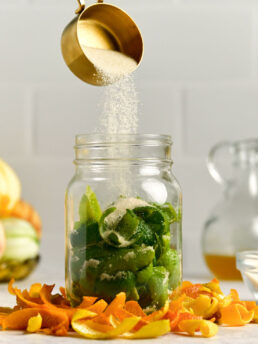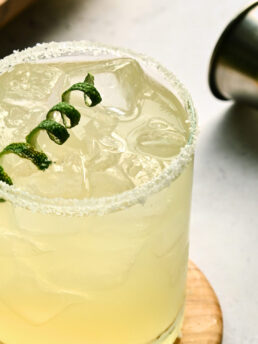Want Perfect Peruvian Ceviche? Use Leche de Tigre with Ají Amarillo.

Move over poke, here comes Peruvian ceviche with leche de tigre. A marinade made with lime juice, fish stock, herbs and aromatics. This simple and delightfully acidic dish, will awaken all of your tastebuds and make them shout for joy!
Speaking of, don’t miss your opportunity to make lime oleo saccharum and margaritas with all that lime peel!

Get the Recipe: Peruvian Ceviche: Leche de Tigre con Ají Amarillo
Ingredients
Leche De Tigre
- 1¾ cup lime juice, fresh squeezed
- 1¼ cup fish stock
- 3 cloves garlic, roasted or raw
- 1 large or 2 small shallots
- 2½ teaspoons kosher salt
- 1½ celery ribs
- 1 tablespoon cilantro stems
- 2 tablespoons fresh ginger, grated
- 1-2 tablespoons ají amarillo paste, (optional, see notes)
Ceviche
- 1 lb fresh, white, saltwater fish
- 4 cups leche de tigre
- ½ large red onion
- ¼ cup fresh cilantro leaves
Equipment
- 1 blender
- 1 cutting board
- 1 chef knife
- measuring Cups
- Measuring spoons
- 1 mixing bowl
Instructions
- First, slice and soak the red onion in ice water. They will need to soak for about 30 minutes.
- Next, juice between 8-16 limes, depending on their juiciness and size (psst. No waste here! Have a spectacular margarita by also making some oleo saccharum). Add the juice and the fish stock to the blender along with the garlic cloves, whole shallots, and salt.
- Next, rough chop the celery ribs (so they can fit into the blender) and chop about 1/4in (.3cm) of the stems at the bottom of a bunch of cilantro. Add these to the blender and proceed to the last step.
- Using the edge of a spoon, peel the skin off a medium finger of ginger so that the yellow meat is showing. Grate the yellow part of the ginger with a microplane or the fine side of a box grater. Scoop up the pulp and add that to the blender.
- Finish the leche de tigre by blending until smooth.
- At this point you can leave the leche de tigre as is, or you can add some spice. This recipe mixes in 2 tablespoons (30ml) of ají amarillo paste, but I suggest you add to taste. (See the FAQ section for using other forms of ají amarillo peppers and different ways to spice leche de tigre)
- Now that the leche de tigre is finished, place it in the refrigerator to chill and take your fish out of the fridge. Place the filet with what would have been the skin side down on the board. Slice and cube the fish into 3/4in (1.9cm) pieces. If you can, each slice should be done in one stroke, pulling the knife towards you. If you run out of knife, stop realign and pull towards you again. (do not saw at the fish)
- Once cubed, gather your toppings and take the leche de tigre out of your refrigerator. Submerge the fish slices into the leche de tigre marinade and let sit for about 30-60 seconds. Using a slotted spoon or tongs move the fish from the marinade to your serving plate and top with cilantro, red onion, and as much marinade as you’d like.
Notes
- If you want to make your own fish stock, from scratch, on the same day as you make the ceviche add 2-3 hours to this recipe time. (This additional time includes: cleaning the fish; cooking the stock; and chilling time)
- The leche de tigre ingredients are all getting blitzed, so fine chopping the vegetables isn’t necessary.
- Serve the ceviche with as much or as little leche de tigre marinade as you like. It’s common to drink leche de tigre. I definitely do.
- The sweet spot for ceviche, texture-wise is between 2-30 minutes in the marinade. Any longer and it will start to turn chalky and tough.
- Balance out the ceviche’s acidity by serving it with sweet or starchy items, like sweet potato, plantains, yucca, or cancha (corn nuts).
Nutrition

Frequently Asked Questions
The best fish to use in ceviche are white-fleshed, saltwater fish that are fresh enough to eat raw, ike sashimi. I love using red snapper, amberjack, and grouper. But, other great options are mahi-mahi, halibut, cobia, sea bass, and flounder.
Note: Tilapia can also be used for ceviche. As it’s more available than some of these other options, I thought it best to mention. Just know, tilapia has a softer flesh than the other listed fish, so it will be harder to cut into slices and will have a different texture.
Fish that are typically not used for ceviche are oily or fatty fish like salmon and tuna. They tend to overpower the delicate flavors in the leche de tigre.
Also a no go are cod or haddock. They are known for having parasites, and unless they were previously frozen to below -4°F (-20°C) for at least 48 hours those suckers (gross pun intended) aren’t dead. Just stick to fish and chips for these fishies.
Yes, a thousand times yes! Some other common items to treat with leche de tigre and eat fresh are shrimp and scallops. If you want to add them to your fish ceviche for a ceviche mixto, here’s how:
– For shrimp you are going to want them butterflied so there is as much surface area as possible for the marinade to cure. You will also want to wait until they look pink and cooked. Otherwise, the texture of your shrimp will be soft and slimy. Yuck.
– For the scallops, slice them the same thickness as the fish for the tiradito, about 1/4in (.6cm) and marinade them until they begin to turn opaque.
Honestly, there isn’t a wrong or right way to marinade your ceviche. Some recipes call for 30 minutes, some say 2 hours, and others want you to soak the fish all day! I prefer a super quick marinade specifically for textural reasons.
The acid in the marinade denatures the proteins in the fish meat. You can literally see this happening in real time as the texture of the outside of the fish toughens and becomes opaque. This would happen to other meats like beef if left long enough in marinades. Fish is far more delicate in structure than a meat, like beef, so it completely skips acidic tenderization and toughens within a minute of being introduced to an acid.
Ehhh…Not really.
Here’s the deal, I know I said the words “denature protein” earlier and all of you smarty pants know that’s what we say when we cook protein, be it bread or steak. But, in this case, you need to re-think the term “cook” and imagine it more like “cure”.
When we cure meats with, usually, salt and/or acid we don’t kill bacteria, we slow it down so much that those meats are safe to eat raw or after being kept for extended periods of time. Now, curing is also dehydrating, something we do not do when we marinade our ceviche. However, the acid and salt in the leche de tigre works in the same way to slow bacterial growth in the fish and flavor it at the same time. We aren’t actively cooking if there is no heat. The fish is still raw. It’s just been treated to maintain freshness and protect against fast bacterial growth.
This does not mean you can simply leave fish out on the counter while it marinades. Keep raw fish as cold as possible if you are not actively consuming it.
Fish for Peruvian ceviche its Japanese fusion cousin, tiradito, need to be fresh enough to eat raw. If you aren’t comfortable eating the fish you buy raw, don’t make ceviche with it. If you have a fishmonger or fish market in town, tell them what you plan to make and ask if one of the fish listed above are a fresh catch-of-the-day.
The best way is to purchase fish from a fishmarket. Asking the employees about when the fish was sourced and broken down ensures you get the freshest ingredients. A good fish market, will smell marine but not fishy, the cutting boards they fillet fish on will be clean and tidy, and they will keep whole fish covered in ice and propped in the position a fish would swim in (to keep stomach contents at the bottom of the fish and not squish the fillet meat).
– If you are buying fillets for ceviche, you want the flesh to be firm, odorless, and not slimy.
– If you are buying whole fish, go for fish with clear eyes, no marred scales, and again nothing with strong odor or any sliminess.
Should you want to make the fish stock for this recipe as well as the ceviche, I suggest getting a whole fish. You can ask your fishmonger to give you the fillets, head, and bones for both applications. They will break everything down for you right there and hand it over in a bag of ice. (more information about this in the fish stock recipe)
This is kind of a po-tay-to/po-tah-to situation. Both ceviche and tiradito are raw fish dressed with leche de tigre. The main differences are these:
– Ceviche is typically cut into cubes like poke and tossed in the leche de tigre for at least a minute before serving.
– Tiradito is sliced like sashimi and the leche de tigre is poured over the fish like a finishing sauce.
I actually prefer tiradito with its Japanese inspiration and Peruvian flavors. Slices of fish just do it for me. If you’d like to update this ceviche recipe into a modern and delicious fusion, here’s how you slice the fish fillets when it’s time to prepare them:
Place the filet with what would have been the skin side down on the board. Then, slice against the grain, at an angle, starting from the tail side and working your way along to filet towards where the head would have been. Each slice should be between 1/4-1/2in (.6-1.3cm) thick, sashimi-like pieces.
Everything else can stay the same, since I basically instruct you to eat the fish as soon as the marinade touches it. Enjoy! ☺️
I have found three different ways ají amarillo peppers are stored and available for purchase.
1. as a paste 2. jarred in a saltwater solution 3. frozen or fresh peppers
PASTE: The paste seems to be the most easily accessible. So, that is what I used in my recipe. The paste is a little earthier than the full peppers in either option. Be aware that it’s not exactly the same flavor as fresh peppers. I feel like all of you already logically knew that, but I’m aiming for more info rather than less.
JARRED: Anywho, if you find and decide to use the jarred peppers, you will want to use 2-3 of them depending on your preference for spice. Make sure to squeeze some of the brine out of the peppers and peel as much of the skin off of them as you can before blending. The skin can be tough and would give your leche de tigre a not so great texture.
If you don’t want to take the time to peel, I get it. Just take care of it on the back end and strain the marinade before use. Also, I suggest holding off on adding any salt to the blender until you’ve tasted the marinade. Because the peppers are preserved in a saltwater solution they bring their own salt to the mix and you may not need any.
FRESH/FROZEN: These peppers are obviously going to be your best option if they are available. To add these to your marinade, first cut up the peppers and sauté them gently until they begin to sweat. You are not trying to add color or char, just soften them. Same deal as the jarred peppers, you can add them to a baggie to steam after cooking them. Then peel the skin before blending or strain after their trip in the blender.
If you don’t add ají peppers to the leche de tigre you can also use habanero peppers. Thinly slice and use them as a topping. Habaneros are a common pepper in this style of ceviche. They are also on the sweeter side, even if they are spicier than the ají pepper.
Ceviche is usually eaten with sweet or starchy items, like sweet potato, sweet corn, plantains, yucca, or cancha (corn nuts).




Looks good. But…you say pit fish in marinade for 30-60 seconds
Then later you say 2-30 minutes
Please explain
Thank you so much for your question. I can see how a little bit of clarification would go a long way here! The 30-60 seconds is meant as a (fully submerged) marinate instruction. After 30-60 seconds you remove the fish from the marinade and begin plating. While the 2-30 minutes is an eat within this time frame (after marinating) instruction. Under 2 minutes, and the fish won’t have built up the correct texture. Over 30 minutes, and the ceviche will have a similar texture to Mexican ceviche, which is tougher. Hope this helps! If you have any other questions, I’m only a message away!
Amazing recipe, do you have any tips how to sweeten the leche de tigre to reach a better balance. Do you also have some input how to thicken the leche de tigre?
Hi! Great questions…
For a less tart leche de tigre, decrease the amount of lime juice to your tastes. It will naturally bring the flavors more in balance. If you actually want added sweetness, I would recommend adding in a simple syrup or regular granulated sugar 1/2 tsp (2.5ml) at a time. If you use something like agave or turbinado, it will detract from the freshness of the marinade.
If you want to thicken the marinade, I suppose you could do that 2 ways: cold or hot. Clearjel or Tapioca Starch don’t need to be heated to thicken liquid. So, make a slurry with 1/4 tsp of either and a small amount of liquid, and then mix that into the rest of the marinade when you blend it. I’d start small and repeat the slurry/blend process to build to your preferred thickness. If you want a heated application, add cornstarch or xanthan gum to the needed amount of fish stock for the recipe. For these, 1/8 tsp is a good start for xantham gum (it’s powerful) and 1 tsp of would work for cornstarch. Bring the stock to a simmer, make a slurry with your chosen thickener and some stock and then mix the slurry into the simmering stock until you’re happy with the texture. For heated thickening, remember that extra liquid is getting added later in the form of lime juice, blended celery, and shallot.
Good Luck! Let me know what you decide and if it worked the way you hoped. 🙂